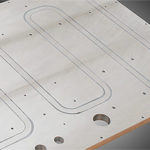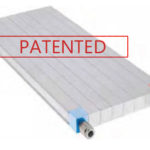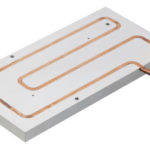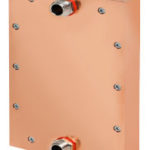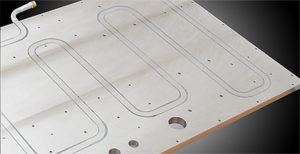 The Cold Plate is the line of heat sinks with forced circulation of liquid, designed for applications with very high thermal loads.
The Cold Plate is the line of heat sinks with forced circulation of liquid, designed for applications with very high thermal loads.
There are different methods of construction ranging from aluminum plate with copper tube placed inside, to the formation of more perforated plates matching profiles for particular performances obtained by mating two shells made with a machine tool to derive the funnels for the coolant.
All liquid cooled heat sinks are tested to a pressure of 8 bar in order to ensure that there is no leakage of liquid.
Application fields:
- Power generation and conditioning
- Lasers
- Medical equipment
- Transportation
- Electronic equipment for military use
- Radio transmitters
- Semiconductor processing equipment
- UPS
The use of water-cooled heat sinks is becoming increasingly common in response to the need of dissipating high power in small spaces and without the use of fans with high air flow. In fact, the water, in virtue of a specific heat much higher than air, it is far more effective as a vector fluid in removing heat from a warm body. A small pump allows the circulation of fluid which must be cooled through a heat exchanger, a remote heat sink or air-cooled by means of a refrigerating unit.
The heat sink plates which are water-cooled find their ideal application whenever it is in the presence of high power and where the thermal load is localized.
There are many fields of use of this type of technology:
- Power electronics
- Continuity groups
- Electromedical equipment
- Industrial equipment of various kinds, such as laser or machines for the production of semiconductors-trains and transport in general
- Equipment for military use
- Radio transmitters
Constructive typologies
A. Pipe Cold Plate
A continuous tube of copper, aluminum or stainless steel is inserted inside a machined plate of aluminum or copper on which the power component will then be set.
The peculiarity of the system is that the holes for the fixing screws do not have rigid constraints of neither position nor of depth and can be made on both sides of the heat sink.
There can be two versions of the heat sink, one with the sight tube and the other with a drowned tube.
B. Perforated Plates
A very thick plate is perforated in order to create inside it a guided path for the refrigerant fluid; the holes are then closed on the outside thanks to screw caps.
Complete systems for heat dissipation with refrigeration unit
All previous systems: Pipe Cold Plate, perforated plates, Flex Fluid modular systems , can be coupled with refrigeration units proposed.
The cost of energy is increasing every year, the global warming treads the eco-system and we often need to dissipate the heat produced by big electronic devices.
In industrial and office buildings, usually big electronic devices o Data Processing Center are cooled with great chillers that waste energy in the air. Big electronic devices can be a solution instead of a problem since we can use them as a source of energy! If associated with Liquid Cold Plates, special reversible chillers can subtract heat by electronic devices and use it to heat a building, or to produce Domestic Hot Water; when the heat request is satisfied the special chiller can automatically dissipate the heat in the air atmosphere or discharge it into groundwater when it is possible. Ellediesse and Rhoss have developed a special Polyvalent chiller that have a main cooling circuit, a recovery circuit and a “waste” circuit or a condensing coil with a fan to dissipate the heat into the air.
The recovered energy can be considered as renewable and so we can reduce the impact of the building on the environment. This solution represents a step toward the integration between electronic and industrial device with the buildings..
Some data:
- With 8 kW you can heat a modern house of about 100 m2.
- With 20 kW you can produce all Domestic Hot Water for an 80 beds hospital
- In a medium DPC we can need to dissipate 80 kW
- A laser can dissipate till to 2 kW
Why use a Liquid Cold Plate?
Perché usare una piastra di dissipazione a liquido?
Since fluid can carry thermal energy much better than air, cooling systems with a circulating fluid have a much bigger heat-sink power that forced or natural convection air dissipated heat-sink.
With a Liquid Cold Plate we can carry away a lot of energy with small dimensions, no air and dust movement, no noise.
Is it safe, or it can wet the electronic device?
We test every single Liquid Cold Plate at pressure of 8 bar; the best components and materials are use for the connections and special silicone sealants are use to ensure a perfect seal and possibility to follow the thermal expansion of the plate.
Why use a chiller?
The use of a chiller allows to control the temperature of water circulating in the liquid cooling circuit so that the electronic component can work at the desired temperature independently from the outdoor temperature.
Complete cooling system and heat recovery systems.
Ellediesse, thanks to an agreement with an Italian producer of chillers, can offer a complete cooling system with chiller, polyvalent chillers, pump, and all safety accessories. All the chillers can be air or water condensed on the waste circuit.(*)
(*) Supply is currently being activated

